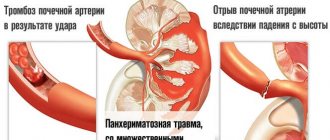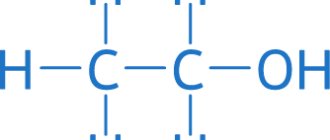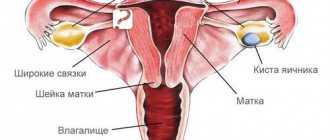Author Andrey Mikhailov
10/25/2002 13:39 (Updated: 07/02/2021 14:25)
Health
Statistics show that pancreatitis has become a very common disease in recent years. For example, in our country there are 27.4–50 cases of chronic pancreatitis per 100,000 people, and the picture is approximately the same in European countries. The number of patients suffering from the acute form of the disease is also increasing: in Russia, the frequency of cases ranges from 10 to 13% of the total number of patients with surgical pathologies of the abdominal organs.
Causes of pancreatitis
The main reasons for the development of pancreatitis:
- Prolonged and excessive consumption of alcohol. Ethyl alcohol increases the saturation of pancreatic juices and provokes a spasm of the sphincter, which regulates their flow into the duodenum. Statistics: 40% of patients with pancreatitis are alcoholic; 70% – periodically abuse alcohol.
- Gallstone disease - a gallstone can cause blockage of the efferent ducts and cause inflammation of the glandular tissue. Statistics: 30% of patients have a history of gallstones.
- Disorders of lipid metabolism associated with overeating and obesity lead to increased production of enzymes, which provokes the risk of inflammation. Statistics: 20% of cases are accompanied by excess weight and lipid metabolism diseases.
- Viral infections, including hepatitis, tuberculosis, chickenpox, mumps, measles, typhoid fever, etc.
- Calcium metabolism disorder – hypercalcemia. Leads to sclerotization (hardening) of gland tissue with disruption of secretory function and spasm of the ducts.
- Autoimmune diseases - some types of allergies can provoke autoimmune aggression of antibodies to the pancreas’s own cells.
- Parasitic infestations - a cluster of large parasites, such as roundworms, that can block the efferent ducts of an organ.
- Damage to the ducts due to injuries and during operations.
- Poisoning or intoxication of the body leads to an overload of enzyme systems with excessive production of digestive juices.
- Endocrine diseases - directly or indirectly affect the functioning of all endocrine and exocrine glands. Disorders of the thyroid gland and diabetes mellitus have a particularly detrimental effect on the pancreas.
- Pathologies of the structures of the digestive system - enterocolitis, colitis, duodenitis, diverticulitis, peptic ulcer, Reye's syndrome (fatty degeneration of the liver).
- Long-term use of certain medications - steroid drugs, certain types of diuretics, antibiotics, sulfonamides.
- Vascular pathologies (arterial hypertension, atherosclerosis) with impaired blood circulation in the pancreas, as well as complications during pregnancy in women.
- Hemolytic diseases - including hemolytic-uremic syndrome.
- Hereditary pathologies (most often cystic fibrosis). The associated thickening of internal secretions, including pancreatic juices, leads to disruption of their outflow.
The causes of pancreatitis can occur independently or in combination. This determines not only the etiology of the disease, but also the degree of its manifestation, severity and therapeutic prognosis.
Repeated attacks of acute pancreatitis provoke the transition of the disease into a chronic form. Due to frequent inflammation, the organ becomes covered with scar tissue (fibrous degeneration) and loses the ability to produce the required amount of enzymes. If the areas that produce insulin (the islets of Langerhans) are damaged, an insulin-dependent form of diabetes mellitus develops.
Severity
Acute pancreatitis, the treatment of which is very difficult, can occur in various forms. The disease is classified depending on the severity:
- The mild form is characterized by the fact that the organ continues to function with minimal impairment. In this case, during instrumental examinations, slight swelling is detected.
- The average form causes complications of a necrotic nature. Against the background of organ failure, malfunctions occur in the functioning of other systems in the human body.
- The severe form is characterized by destruction by a strong inflammatory process, which often leads to purulent infected tissue necrosis. This can damage nearby organs.
How pancreatitis manifests itself: symptoms and signs
The main list of symptoms in the acute form:
- severe pain in the hypochondrium - taking into account the cause of the disease and accompanying pathologies, it can be girdling, right- or left-sided;
- reactions from the digestive tract - hiccups, belching with an unpleasant odor, nausea and repeated bouts of vomiting, constipation or diarrhea;
- general deterioration of the body - dehydration, dry mouth, weakness, increased or decreased blood pressure, shortness of breath, increased sweating, high temperature;
- external manifestations are dull, sallow-colored skin, bluish or brownish spots in the lumbar region and supra-umbilical area, obstructive jaundice is possible.
Attention! The acute form requires urgent hospitalization followed by hospital treatment.
In the chronic form, the signs of pancreatitis are less pronounced:
- pain appears only after eating fried and fatty foods or alcohol; the rest of the time, mild discomfort may be observed in the hypochondrium area;
- reactions from the digestive system appear only in the dyspeptic form in the form of flatulence, diarrhea or constipation;
- external skin manifestations in the form of mild jaundice; with prolonged absence of treatment, weight loss, anemia, and type 2 diabetes are observed.
In the latent stage, the disease is asymptomatic; in the fibrous form, scar tissue can grow to form pseudotumor structures.
Important! Pancreatitis of the pancreas rarely manifests itself as an independent disease. Typically, the pathological process combines several digestive organs, involving the hepatobiliary system (liver, gallbladder and ducts), duodenum, and stomach. This fact requires diagnosing the entire human digestive system.
How is pancreatitis examined?
Diagnosis and treatment of pancreatitis are the responsibility of a gastroenterologist. To make a diagnosis, the doctor collects anamnesis, conducts an examination and prescribes diagnostic procedures.
Medical examination
The procedure includes assessing the condition of the skin, eye sclera, tongue, and the functioning of the salivary glands. The patient is then placed on the couch and palpated and tapped to identify objective symptoms of pancreatitis:
- Mussi-Georgievsky's symptom, or phrenicus symptom - painful sensations when pressing with your fingertips in the area above the left collarbone - where the phrenic nerve passes between the legs of the sternocleidomastoid muscles;
- sensitivity in the Shoffar area - in the area of the projection of the head of the pancreas, 5-6 cm above and to the right of the navel;
- Gubergrits-Skulsky symptom - pain manifests itself in the area of the projection of the body of the pancreas, slightly to the left of the Shoffard zone;
- pain in the Mayo-Robson area – left costovertebral angle – area of the tail of the pancreas;
- Desjardins' symptom - sensitivity at a point located 5-6 cm above the navel along the line connecting the navel and the armpit; like the Choffard area, the point is a projection of the head of the pancreas;
- hypotrophic Grotta sign - lack of subcutaneous fat in the area of gland projection;
- Tuzhilin’s hemorrhagic symptom, or the “red droplets” symptom, manifests itself in the form of small burgundy rashes or brown pigmentation over the gland area;
- Kach's symptom - pain on palpation at the exit of the nerve processes at the level of the thoracic vertebrae: 8-9th - on the left, 9-11 - on the right.
- Voskresensky's symptom - with an enlarged pancreas with swelling of the tissue, the pulse of the abdominal aorta cannot be palpated.
Together with the survey, palpation allows you to determine the presence of dyspeptic phenomena from the digestive tract: flatulence, belching, nausea, diarrhea, constipation.
Attention! A sign of chronic pancreatitis may be severe weight loss. It develops as a result of disruption of the process of food digestion against the background of a decrease in the secretory function of the gland and enzyme deficiency. Accompanied by increased dry skin, anemia, dizziness.
Diagnostic procedures
Laboratory diagnostic methods:
- a general blood test reveals signs of inflammation - high levels of leukocytes, low ESR;
- a biochemical blood test determines the level of pancreatic enzymes - amylase, alkaline phosphatase, as well as the pigment bilirubin;
- urine analysis shows the residual content of the enzymes amylase and diastase;
- tubeless diagnostic methods assess the activity of the digestive process by introducing substrates for pancreatic enzymes and then monitoring their absorption;
- Stool analysis for parasites is carried out as necessary.
Toolkit of techniques:
- Ultrasound – determines the shape and size of the organ, the presence of compactions and fibrous areas;
- gastroscopy - assesses the degree of inflammation of the walls of the stomach and duodenum;
- radiography and its variant - endoscopic retrograde cholangiopancreatography - help to detect accumulations of clots or stones in the ducts that cause blockage;
- probe methods for determining the exocrine function of the gland - secretin-pancreozymin test, Lund test;
- CT or MRI allows you to assess the degree of tissue necrosis in severe patients;
- Laparoscopy is used in difficult cases for visual assessment and tissue biopsy.
How to treat pancreatitis of the pancreas
Three rules in the treatment of this pathology - rest, cold and hunger:
- rest slows down blood circulation and reduces blood flow to the diseased organ;
- cold compresses on the hypochondrium area reduce the temperature of inflammation and the severity of pain;
- Fasting for 1-6 days stops the production of enzymes that cause inflammation.
Additionally, conservative treatment is prescribed using medications, physiotherapy and herbal medicine.
Drug treatment:
- antispasmodics and NSAIDs to eliminate spasms of the gastrointestinal tract and inflamed pancreas;
- antibiotics - with an active infectious process;
- antisecretory drugs - to suppress external (enzyme) and internal (hormonal) secretion;
- pancreatic enzymes - to maintain healthy digestion during the period of treatment, as well as in case of significant degeneration of glandular tissue;
- Insulin preparations – in case of damage to hormone production areas.
Physiotherapy is included in treatment after the acute phase of inflammation has resolved. The most effective methods:
- electrophoresis with painkillers and anti-inflammatory drugs increases the intensity of their action, better relieves pain and inflammation;
- ultrasound is used as an anesthetic for shingles pain syndrome;
- diadynamic currents - exposure to low-frequency impulses improves blood supply, enhances tissue metabolism, relieves pain;
- laser and UV irradiation of blood relieve inflammation, improve microcirculation of liquid media and tissue regeneration;
- an alternating magnetic field successfully helps eliminate swelling and inflammation.
Herbal medicine is used as an accompanying treatment - to enhance the effect of medications and eliminate possible side effects. For these purposes, plants with anti-inflammatory, detoxifying, antispasmodic, and calming effects are used. These include chamomile, calendula, St. John's wort, wormwood, dandelion, burdock, golden mustache, motherwort, immortelle, barberry, caraway and a number of other herbs that are used both individually and as part of complex collections.
In severe cases, when conservative treatment methods do not help, they resort to surgical removal of the organ or part of it, followed by the appointment of enzyme replacement therapy on an ongoing basis. Indications: complete disintegration of the organ, the presence of cysts, necrosis, tumors, abscesses, fistulas, persistent blockage of the ducts with stones.
After the acute inflammation is relieved, a special diet is prescribed. In case of chronic pancreatitis or in the case of surgical treatment of the gland, it should be lifelong.
Nutrition in the acute phase
In addition to knowing how to relieve an attack of pancreatitis at home, you need to learn some nutritional rules. By following a certain diet, you can smooth out the clinical manifestations of acute pancreatitis and reduce the frequency and duration of exacerbation phases.
Principles of proper nutrition during illness:
- exclusion of foods containing fats, carbohydrates (especially sugar and foods containing it);
- increasing the volume of products with lean proteins;
- exclusion of fried, fatty, coarse fiber;
- maintaining fractional meals (small portions, but often throughout the day).
For pancreatitis, it is important to consume many vitamins and beneficial micro- and macroelements, and since it is difficult to get them all from food, doctors recommend taking synthetic drugs.
In the acute stage of pancreatitis, foods (except those prohibited) must be crushed before consumption, boiled or steamed. Frying is prohibited.
Diet in the first and subsequent days
During the first two days of exacerbation of the disease, a person is prohibited from eating. It is only permissible to drink mineral water (not carbonated). This helps to suppress the secretion of pancreatic juice, reduce the intensity of pain, and remove toxic substances and breakdown products from the body. Mineral water can be replaced with rosehip decoction.
On the third day, the diet can be diversified by including ground food. The following foods should not be included in the diet:
- salt-containing;
- fats and carbohydrates;
- coarse fiber;
- hot seasonings, smoked meats, spices;
- marinades, onions, garlic;
- baking;
- alcohol.
After reducing the intensity of inflammatory manifestations, you can eat puree soup, lean meats, fish, cottage cheese, cereals and vegetables (in addition to cabbage, which increases gas formation). You can drink fruit and vegetable juice, fermented milk products (yogurt, kefir, etc.).
How long the diet will last depends on the characteristics of the development of the disease. The average duration is 6-12 months.








